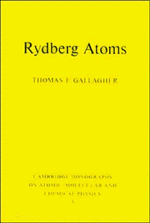Book contents
- Frontmatter
- Contents
- Preface
- 1 Introduction
- 2 Rydberg atom wavefunctions
- 3 Production of Rydberg atoms
- 4 Oscillator strengths and lifetimes
- 5 Black body radiation
- 6 Electric fields
- 7 Pulsed field ionization
- 8 Photoexcitation in electric fields
- 9 Magnetic fields
- 10 Microwave excitation and ionization
- 11 Collisions with neutral atoms and molecules
- 12 Spectral line shifts and broadenings
- 13 Charged particle collisions
- 14 Resonant Rydberg–Rydberg collisions
- 15 Radiative collisions
- 16 Spectroscopy of alkali Rydberg states
- 17 Rf spectroscopy of alkaline earth atoms
- 18 Bound He Rydberg states
- 19 Autoionizing Rydberg states
- 20 Quantum defect theory
- 21 Optical spectra of autoionizing Rydberg states
- 22 Interseries interaction in bound states
- 23 Double Rydberg states
- Index
21 - Optical spectra of autoionizing Rydberg states
Published online by Cambridge University Press: 29 September 2009
- Frontmatter
- Contents
- Preface
- 1 Introduction
- 2 Rydberg atom wavefunctions
- 3 Production of Rydberg atoms
- 4 Oscillator strengths and lifetimes
- 5 Black body radiation
- 6 Electric fields
- 7 Pulsed field ionization
- 8 Photoexcitation in electric fields
- 9 Magnetic fields
- 10 Microwave excitation and ionization
- 11 Collisions with neutral atoms and molecules
- 12 Spectral line shifts and broadenings
- 13 Charged particle collisions
- 14 Resonant Rydberg–Rydberg collisions
- 15 Radiative collisions
- 16 Spectroscopy of alkali Rydberg states
- 17 Rf spectroscopy of alkaline earth atoms
- 18 Bound He Rydberg states
- 19 Autoionizing Rydberg states
- 20 Quantum defect theory
- 21 Optical spectra of autoionizing Rydberg states
- 22 Interseries interaction in bound states
- 23 Double Rydberg states
- Index
Summary
QDT enables us to characterize series of autoionizing states in a consistent way and to describe how they are manifested in optical spectra. We shall first consider the simple case of a single channel of autoionizing states degenerate with a continuum. Of particular interest is the relation of the spectral density of the autoionizing states to how they are manifested in optical spectra from the ground state and from bound Rydberg states using isolated core excitation. We then consider the case in which there are two interacting series of autoionizing states, converging to two different limits, coupled to the same continuum.
First we consider the two channel problem shown in Fig. 21.1. Our present interest is in the region above limit 1, i.e. the autoionizing states of channel 2. Later we shall consider the similarity of the interactions above and below the limit. A typical quantum defect surface obtained from Eq. (20.12) or (20.40) for all energies below the second limit is shown in Fig. 21.2. The surface of Fig. 21.2 may be obtained with either of two sets of parameters, δ1 = 0.56, δ2 = 0.53, and R′l2 = 0.305, R′11 = R′22 = 0 or μ1 = 0.4, μ2 = 0.6, and U11 = U22 = cosθ and U12 = – U21 = sinθ, with θ = 0.6 rad. To conform to the usual convention, in Fig. 21.2 the vi axis is inverted.
- Type
- Chapter
- Information
- Rydberg Atoms , pp. 429 - 452Publisher: Cambridge University PressPrint publication year: 1994



